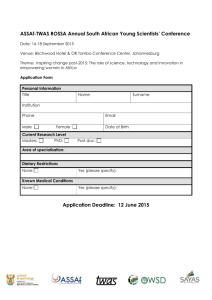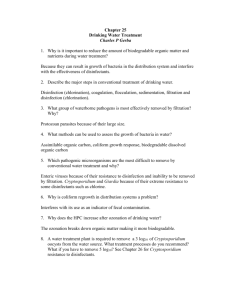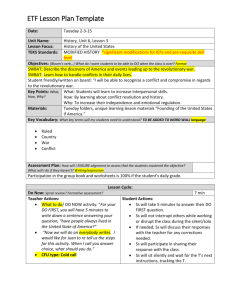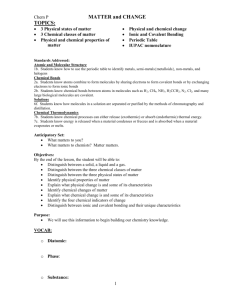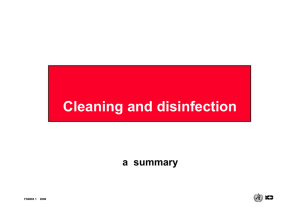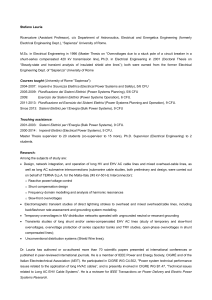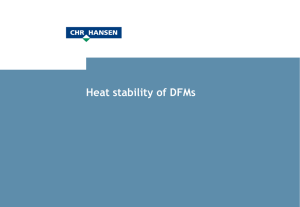to the possibility of calculation
advertisement
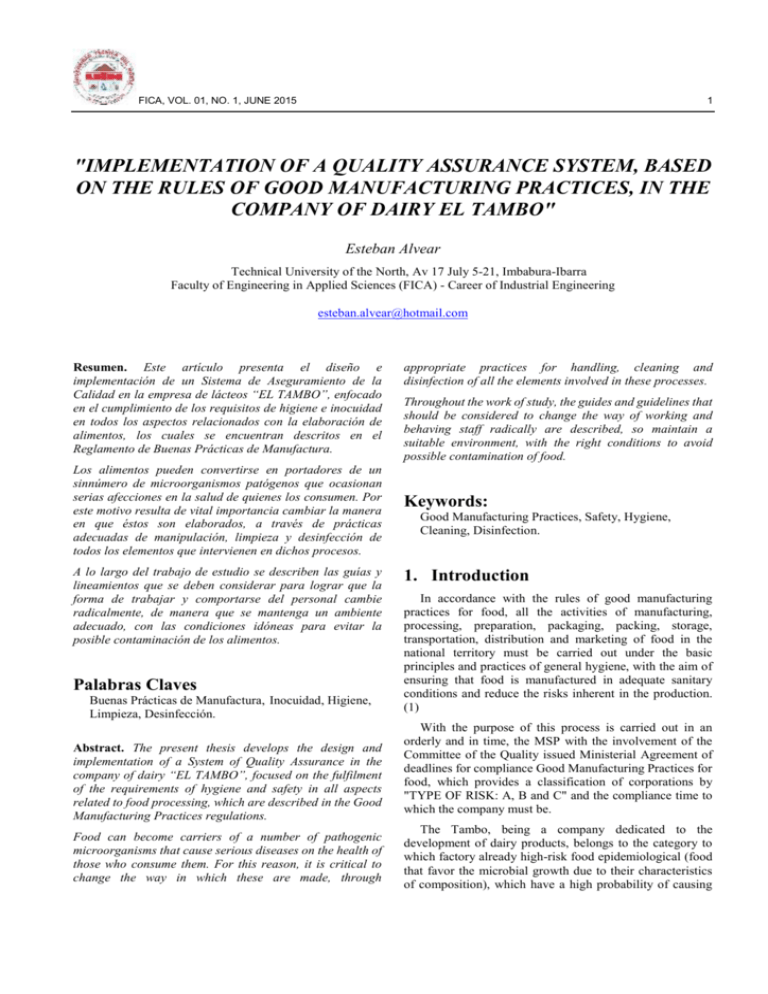
FICA, VOL. 01, NO. 1, JUNE 2015 1 "IMPLEMENTATION OF A QUALITY ASSURANCE SYSTEM, BASED ON THE RULES OF GOOD MANUFACTURING PRACTICES, IN THE COMPANY OF DAIRY EL TAMBO" Esteban Alvear Technical University of the North, Av 17 July 5-21, Imbabura-Ibarra Faculty of Engineering in Applied Sciences (FICA) - Career of Industrial Engineering esteban.alvear@hotmail.com Resumen. Este artículo presenta el diseño e implementación de un Sistema de Aseguramiento de la Calidad en la empresa de lácteos “EL TAMBO”, enfocado en el cumplimiento de los requisitos de higiene e inocuidad en todos los aspectos relacionados con la elaboración de alimentos, los cuales se encuentran descritos en el Reglamento de Buenas Prácticas de Manufactura. Los alimentos pueden convertirse en portadores de un sinnúmero de microorganismos patógenos que ocasionan serias afecciones en la salud de quienes los consumen. Por este motivo resulta de vital importancia cambiar la manera en que éstos son elaborados, a través de prácticas adecuadas de manipulación, limpieza y desinfección de todos los elementos que intervienen en dichos procesos. A lo largo del trabajo de estudio se describen las guías y lineamientos que se deben considerar para lograr que la forma de trabajar y comportarse del personal cambie radicalmente, de manera que se mantenga un ambiente adecuado, con las condiciones idóneas para evitar la posible contaminación de los alimentos. Palabras Claves Buenas Prácticas de Manufactura, Inocuidad, Higiene, Limpieza, Desinfección. Abstract. The present thesis develops the design and implementation of a System of Quality Assurance in the company of dairy “EL TAMBO”, focused on the fulfilment of the requirements of hygiene and safety in all aspects related to food processing, which are described in the Good Manufacturing Practices regulations. Food can become carriers of a number of pathogenic microorganisms that cause serious diseases on the health of those who consume them. For this reason, it is critical to change the way in which these are made, through appropriate practices for handling, cleaning and disinfection of all the elements involved in these processes. Throughout the work of study, the guides and guidelines that should be considered to change the way of working and behaving staff radically are described, so maintain a suitable environment, with the right conditions to avoid possible contamination of food. Keywords: Good Manufacturing Practices, Safety, Hygiene, Cleaning, Disinfection. 1. Introduction In accordance with the rules of good manufacturing practices for food, all the activities of manufacturing, processing, preparation, packaging, packing, storage, transportation, distribution and marketing of food in the national territory must be carried out under the basic principles and practices of general hygiene, with the aim of ensuring that food is manufactured in adequate sanitary conditions and reduce the risks inherent in the production. (1) With the purpose of this process is carried out in an orderly and in time, the MSP with the involvement of the Committee of the Quality issued Ministerial Agreement of deadlines for compliance Good Manufacturing Practices for food, which provides a classification of corporations by "TYPE OF RISK: A, B and C" and the compliance time to which the company must be. The Tambo, being a company dedicated to the development of dairy products, belongs to the category to which factory already high-risk food epidemiological (food that favor the microbial growth due to their characteristics of composition), which have a high probability of causing 2 E. ALVEAR. damage to the health of consumers because they are products of mass consumption. (2) The implementation of a Quality Assurance System is related to the achievement of the goal number 3 of the National Plan of good living, improve the quality of life of the population, which provided that "The quality of life begins with the full exercise of the rights of the Good Life: water, food, health, education and housing, as a prerequisite to achieve the conditions and the strengthening of capacities and potential individual and social." (3) Currently the dairy products company El Tambo, located in the town of Cayambe, not account with appropriate methods of cleaning and disinfection in the different areas, a factor that favors the proliferation of bacteria and therefore the contamination of the products. For that reason requires a system of quality assurance, through which are properly managed processes and demonstrate the company's ability to issue harmless products. Once implemented the system and using the correct application of the basic principles and practices of general hygiene, along with the necessary changes to the infrastructure, the company The Tambo obtain certification of BPM, essential requirement for the renewal of its operating permit and show that the consumer runs no risk to consume their products. 2. Methods 2.1 Evaluation Form (Check List) The diagnosis of the initial situation of the plant for the production of products "TAMBO" was based on the application of the form of verification of compliance with Good Manufacturing Practices issued by the Public Health Ministry of Ecuador. The rating assigned to each item is 0 - 3 points, according to their status of compliance: 0 Does not meet 1 Partially meets 2 Satisfactorily Meets 3 Meets very satisfactorily Table. 1.Qualification of items in the Check List. Products "TAMBO" won a total rating of 878 points, which represent a percentage of compliance with the 57.05 %, which is evidence that the company did not properly adhered to the requirements set forth in the Rules of Good Manufacturing Practices for processed food and therefore cannot guarantee food safety and quality of the products it develops. The following summary table shows the percentages of compliance pertaining to each point considered by the rules of good manufacturing practices for processed foods. Parameters No. Items Max Score. Score % Fulfilment Facilities 154 462 296 64.07 % Equipment and utensils 74 222 154 69.37 % Staff 60 180 107 59.44 % Raw materials and inputs 37 111 81 72.97 % Production Operations 43 129 65 50.39 % Packaging, labelling and packaging 27 81 27 33.33 % Storage, distribution and transport 31 93 60 64.52 % Quality assurance and control 87 261 88 33.72 % OVERALL TOTAL 513 1539 878 57.05 % Table. 2. Initial rates of compliance with the Regulations of BPM. FICA, VOL. 01, NO. 1, JUNE 2015 3 Compliance with BPM 100,00% 90,00% 80,00% 70,00% 64,07% 72,97% 69,37% 64,52% 59,44% 60,00% 50,39% 50,00% 33,33% 40,00% 33,72% 30,00% 20,00% 10,00% 0,00% Situation and conditions of the facilities Staff Production Operations Storage, distribution and transport Equipment and utensils Raw materials and inputs Packaging, labelling and packaging Quality assurance and control Figure. 1 Compliance with the Regulations of BPM 2.2 Microbiological analysis of the finished product The microbiological analysis of food represent an effective indicator for assessing the safety of a productive process. The microbiological analysis lets you know if the food being produced contain pathogenic microorganisms, i.e. bacteria and fungi. This analysis is carried out by means of crops produced in order to identify them. Among the major pathogens that may be present in the food, we have coliform, E. coli, staphylococci, molds, salmonella and the yeast. The purpose of conducting these analyzes is, by its results, identify if there is any risk to the health of those who consume the products analyzed and, in addition, determine the elements that expose them to the pollution in order to prevent this from happening. Microbiological Parameters The microbiological parameters to analyze allow you to define the acceptability of the products of the company "THE TAMBO", in this case the fresh cheese and yogurt of strawberry, based on the absence, presence or the number of microorganisms per gram. Counting colonies or in standard plate count It is based on counting the colonies of microorganisms that develop after passage in an appropriate culture medium, incubated at a temperature, and time certain a certain volume of sample. Is used to determine the number of isolated cells or unicellular microorganisms viable (able to divide and generate offspring) such as bacteria, yeasts, is also used for the counting of fungal spores present in the sample (4) Total coliform count The term coliform bacteria is used to designate the Enterobacteriaceae most frequently found in dairy products. The count of these bacteria is one of the most significant means for the appreciation of the hygienic quality of the milk. Several species of the family Enterobacteriaceas family specifically are those responsible for serious infectious diseases, which can acquire epidemic character, in the case of dairy products the salmonella are the most fearsome. (5) Escherichia coli Count Escherichia coli is a germ whose natural habitat is the enteric tract of man and other warm-blooded animals. Why the presence of this organism in a food usually indicates a direct or indirect contamination of fecal origin. High numbers of Escherichia coli in a food suggest a lack of cleanliness in the handling of the same and improper storage. (6) Count of molds and yeasts The developmental expression of the yeast in the food can be distinguished from the observed by the molds. While the former may proliferate in the inner mass of the food (solid such as cheeses, or liquids such as fruit juices), the molds are limited to regular to surfaces, visibly badges without any need for the increase, (7) 4 E. ALVEAR. Analysis of results 2.3 Improvement Plan Results Parameter analyzed Unit Standard plate count in Total coliform count Escherichia coli Count Mold count Yeast Count Yogurt Fresh Cheese CFU/g < 10 3300 CFU/g < 10 < 10 CFU/g < 10 < 10 CFU/g CFU/g < 10 < 10 100 < 10 Test Method AOAC 989.10 AOAC 997.02 Table. 3.Results of the microbiological analysis. To assess whether the values obtained in the microbiological analysis made the Fresh Cheese comply with the legal regulations are used as reference the following rules. Maximum Rate Requirement Unit for good quality Maximum Rate for quality CFU/g 2X102 103 Escherichia coli CFU/g <10 10 Parameters (Fresh Cheese) NTE INEN 1528:2012 Maximum Requirement Unit Rate for good quality Count of molds and yeasts Table. 5. Requirement CFU/g Maximum Rate for acceptable quality 500 5000 Maximum Maximum Rate Rate for good for acceptable quality quality Total Coliforms CFU/g 10 100 E. coli count CFU/g <1 - CFU/g 200 500 Count of molds and yeasts Table. 6. The structured improvement plan for the company "Tambo" includes changes in the infrastructure of the plant and the elaboration of a set of interrelated documents that help the standardization of productive processes, cleaning, and disinfection, as well as to demonstrate the proper fulfilment of the corresponding activities. The same as those described below. 2.4 Standardized Operating Procedures In order to ensure consistency, reproducibility and consistency of the characteristics of the products or processes carried out in a company it is necessary the appropriate management of the staff through standardized operating procedures (POE) ... These are the ones written procedures that describe and explain how to perform a task to achieve a specific purpose, in the best possible way. There are several activities and operations, in addition to the cleaning and disinfection, which are carried out in a establishment processor of food that it is convenient and standardize producing a written record of it in order to avoid mistakes that could threaten the safety of the final product. 2.5 Instructive Parameters (Fresh Cheese) NTC 750 Unit The improvement plan is composed of the strategic decision of what changes are to be carried out in each of the different areas and processes of the company, based on the initial diagnosis, to be translated into better performance throughout the organization. acceptable Enterobacteriaceae Table. 4. The excellence of a company depends on its ability to continually improve each one of the processes that govern their daily activity. The improvement is when the company learns from itself and other, always taking into account the changing environment that surrounds it. Parameters (yogurt) NTE INEN 2395:2011 A comparison of the results obtained in both the cheese and yogurt products demonstrate that both comply with the requirements set forth by the relevant legal provisions, identifying them as products of good quality. These documents describe in a detailed way the steps to follow in order to carry out correctly certain support activities (sampling, preparation of cleaning solutions) or for the correct behavior, use of safety equipment and hygiene of the personnel working in the company and the visitors, in such a way as to avoid contamination of the products in any area of production areas. 2.6 Cleaning and disinfection programs Cleaning and disinfection programs described in a general way surfaces or items that need to be cleaned and disinfected in each of the areas of the company. These documents show the frequency with which must be carried out these activities, the type of solution that should be used and its dosage POES along with the reference which describes specifically how to carry out the cleaning and disinfection of each element. Cleaning and disinfection operations have as main objective provide clean and safe environments, related to the FICA, VOL. 01, NO. 1, JUNE 2015 5 toilet and the hygiene of all elements that are used in the processes of the company. This goal is achieved through the implementation of effective procedures that prevent pollution or the proliferation of microorganisms that can affect the quality and safety of the product. 2.7 Standardized Operating Procedures for sanitation The POES are practices and procedures of sanitation writings that an establishment fortifier of food should develop and implement to prevent direct contamination or adulteration of the food producing, processing, subdivide and/or marketed. If the establishment or the Health Authority will detect that the POES fault in the prevention of contamination or adulteration of the product, it must implement corrective measures. These will include the proper disposal of the product concerned, the restoration of the health conditions and take action to prevent its recurrence. Figure. 2 Junctions of the products Significant changes took place in the company's infrastructure, in such a way as to avoid contamination of food by aspects related to walls, floors, windows, doors or roofs. 2.8 Records The establishment must also bear daily records sufficient to document compliance and monitoring of all the procedures carried out in the company and any corrective action taken. These records must be available when the Health Authority so requests. 3. Results 3.1 Evidence of compliance In this section, you can see the changes that have taken place in the product, the infrastructure of the production facility and changes of utensils and behavior of the staff. Currently the products comply with the requirement of junctions. The labels include a graphics system with color bars placed in a horizontal way. These colors are red, yellow and green as the concentrations of the components: fat, salt, sugar, and depending on the concentration of each component. Figure. 3. Changing walls and floors in the area of production of cheeses 6 E. ALVEAR. Some utensils were changed because the material facts that were presented porosity, which hindered their cleaning and disinfection and therefore compromised the safety of the product. There is also evidence the application of cleaning and disinfection procedures. Signaling was placed of security, of prohibition, of danger and obligation and they identified the lines correctly according to the colors defined in the NTE INEN- 440:1984. Figure. 6. Changing color and identification of lines Figure. 4 Change and disinfection of utensils 3.2 Final Evaluation After the implementation of the quality, assurance system in dairy products company "TAMBO" was carried out the evaluation of final terms, which was conducted using the same Check List used for the initial diagnosis. Unlike the initial evaluation, in this form only have been taken into account 513 items applicable because it has ceased to consider aspects such as the use of gloves, discarded by results of safety tests using swabs of the hands, among others. Not all the activities that have been proposed in the plan of improvement have been implemented; this is because some of them are as a recommendation to the management of the company will be able to act according to the availability of the resources necessary for its realization The summary table is shown below with the results of each category and the percentages of compliance with each of them: Figure. 5 POES Application. FICA, VOL. 01, NO. 1, JUNE 2015 Parameters No. Items Max Score. 7 Score % Fulfilment 151 456 369 81.46 % Equipment and utensils 74 222 204 91.89 % Staff 60 180 156 86.67 % Raw materials and inputs 37 111 91 81.98 % Production Operations 43 129 106 82.17 % Packaging, labelling and packaging 25 75 60 80.00 % Storage, distribution and transport 31 93 72 77.42 % 84 252 193 76.59 % 505 1515 1251 82.57 % Facilities Quality assurance and control OVERALL TOTAL Products "TAMBO" won a total score of 1235 points, which represent a percentage of compliance with the 82.57 %, as opposed to the 57.05 % of initial compliance. This result demonstrates that the company complies with the requirements set forth in the Rules of Good Manufacturing Practices for processed food and therefore that, if it keeps improving, you can ensure food safety and quality of the products it develops. In this graph, you can see visually the improvement has been achieved in the various parameters that have been worked on in the course of this thesis project. This improvement has been achieved through the standardization of productive processes and cleaning and disinfection, its documentation and the establishment of strict parameters that must be met at each stage of the various processes within the company. Table. 7.Final percentages of compliance with the Regulations of BPM. Comparison Situation of BPM 100,00% 90,00% 91,89% 86,67% 82,17% 81,98% 81,46% 80,00% 80,00% 77,42% 76,59% 70,00% 60,00% 50,00% 40,00% 30,00% 64,07% 72,97% 69,37% 59,44% 64,52% 50,39% 20,00% 33,72% 33,33% 10,00% 0,00% FACILITIES EQUIPMENT AND UTENSILS STAFF MP AND INPUTS OPERATIONS PACKAGING AND PACKING Initial End Figure. 6. Changing color and identification of lines STORAGE QUALITY 8 E. ALVEAR. of continuous improvement, you can ensure food safety and quality of the products it develops. 3.3 Microbiological analysis End One of the main objectives of the implementation of the quality assurance system was to improve the safety of the product, it is crucial to attain a microbiological analysis after deployment to compare the results obtained with the results of the initial analysis. Table. 8.Results of microbiological analysis End Parameter analyzed Results Unit Test Method Count Aerobic mesophiles CFU/g ----- Fresh Cheese 20 Total coliform count CFU/g < 10 < 10 Escherichia coli Count CFU/g 0 0 Mold count CFU/g 15 12 Yeast Count CFU/g 4 25 AOAC 997.02 Salmonella spp. (PRES/absence 25g) ------- Absenc e Absenc e AOAC 967.26 Yogurt AOAC 989.10 The results obtained in the analysis show that comply with the parameters specified in the rules of legal reference. In the molds and yeasts is submitted a minimum increase due to the time of storage of the products at the time of the analysis, however, they are well below the parameters considered in the standard as parameters of acceptable quality, even the parameters of good quality. The count of Escherichia coli has been reduced to zero, the count of aerobic mesophiles shows that is has been a significant decline in the number of colonies of microorganisms in the sample and shows a lack of salmonella, which is evidence that have been improved practices in the handling and processing of the food in the dairy products company "THE TAMBO". In this way, it is shown that the Quality Assurance System implemented satisfactorily meets the goal of improved food safety and hygiene through improving the processes based on the correct observance of the Rules of Good Manufacturing Practices for processed foods. 4. Conclusions: Through the implementation of the quality assurance system it was possible to obtain a compliance percentage of 82.57 %, noting a significant improvement compared to the 57.05 % of initial compliance. This result demonstrates that the company complies with the requirements set forth in the regulation of BPM and therefore that, if it keeps the process The percentage of compliance with the item of raw materials and inputs increase of 72.97 % to 81.98 %. Through the establishment of quality parameters for the acceptance raw materials and the verification of compliance with the same, is completely eliminates the risk that the products are manufactured with raw materials in poor condition or of poor quality. The percentage of compliance with the item of equipment and utensils was increased from 69.37 % to 86.67 %. With the change of the material of the utensils used in the preparation of food, wood to stainless steel, was successful in reducing the potential sources of contamination of the product. In the same way with the elimination of the utensils that are broken or patches made with materials that impede their cleaning. The percentage of compliance with the item of Quality Assurance and Control increase of 33.72 % to 76.59 %. The criteria for acceptance or rejection of the finished products of the fulfillment of the quality parameters specified in the documentation allow you to maintain the prestige of the company and prevent consumers acquire a product in bad conditions, aspect that would generate large losses for the company. The percentage of compliance with the item of packaging, packaging and labelling increased from 33.33 % to 80.00 %. The change of supplier for packaging, junctions and the quality control of products through the identification of the same with the labeling system generated a significant improvement. The percentage of compliance with the item of facilities increased from 64.07 % to 81.46 %. Changed the locations of the area of machines and the bathroom to the outside of the main building, in the same way the change of floors and walls easier to clean and therefore better conditions for the preparation of food. It was obtained that the E. coli count reaches zero. In microbiological analysis made you can appreciate the change that has occurred concerning food safety, having reduced the presence of pathogenic microorganisms that could cause diseases in the consumers of the products considerably. FICA, VOL. 01, NO. 1, JUNE 2015 Acknowledgments: The Economist WINSTON OVIEDO, for his unconditional support and dedication to guide me with their knowledge throughout the development of this work. To the Company THE TAMBO and their owners for having opened the doors of the same and for their collaboration in order to be able to carry out this work of study Bibliographic references: (1). Executive Decree No. 3253 ( Regulation of Good Manufacturing Practices for Processed Foods) published in the R. OR No. 696 of 4 November 2002 (2). Official Register 839. (27 November 2012) (3). Secretariat of National Planning and Development Senplades. (2013). National Plan for Healthy Living". Quito: Senplades. (4). UNAD. (December 11 2014). Microbiology. Obtained from bacterial counting techniques: http://datateca.unad.edu.co/contenidos/201504/co ntLinea/leccin_30_tcnicas_de_recuento_bacterian o.html (5). Alais, C. (2001). Science of the milk. Mexico: Continental Publishing Company. (6). EcuRed. (December 11 2014). Food microbiology. Obtained from http://www.ecured.cu/index.php/Microbiolog%C3 %ADa_de_los_alimentos (7). EcuRed. (December 11 2014). Food microbiology. Obtained from http://www.ecured.cu/index.php/Microbiolog%C3 %ADa_de_los_alimentos About the Author... Esteban Alvear: He was born in Quito on July 20 1991, currently residing in the city of Ibarra (Barrio Los Ceibos). He is graduated of the career of Industrial Engineering at the Technical University of the North. 9
